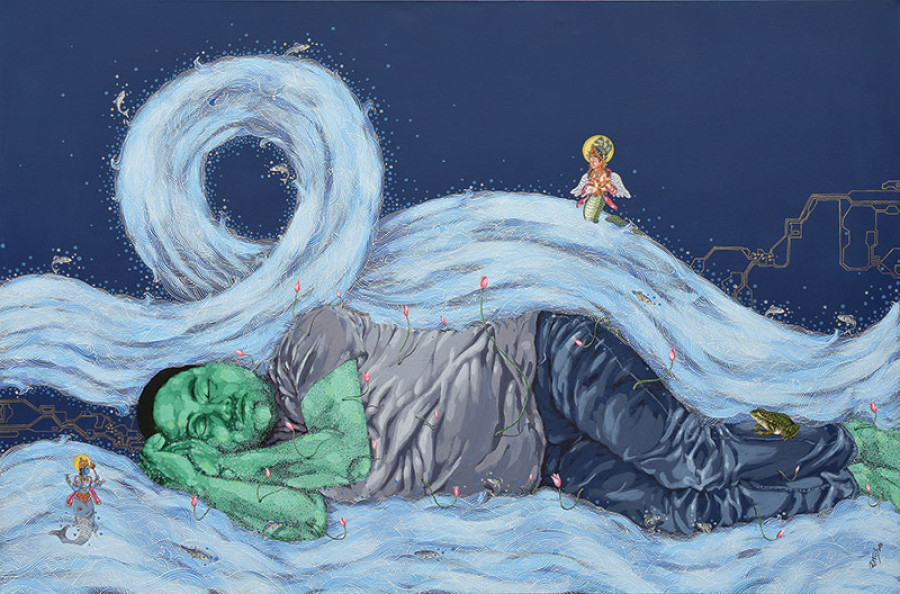Entertainment
Love and Attachment
The exhibition at Siddhartha Art Gallery that started on the 24th of last month, and currently on show, is a collection of paintings by Prithvi Shrestha, the first recipient of a newly instituted bursary by the Himalayan Light Foundation, founded by senior Chinese artist Zhao Jianqiu in 2015.
Kurchi Dasgupta
The exhibition at Siddhartha Art Gallery that started on the 24th of last month, and currently on show, is a collection of paintings by Prithvi Shrestha, the first recipient of a newly instituted bursary by the Himalayan Light Foundation, founded by senior Chinese artist Zhao Jianqiu in 2015. ‘The scholarship intends to encourage young artists to explore deeper into their skills and the myriad of themes in Nepali art, and also hopes to create opportunities for more trans-Himalayan artistic exchange in the future,’ wrote Justin Zhao, the Director of the foundation, in the catalogue.
Attachment is Prithvi Shrestha’s fifth solo show and explores the entwined concepts of ‘nature, ritual, religion and culture’. About 15 acrylic on canvas pieces compose this exhibit, with the artist himself as their focal subject. As gallery director, Sangeeta Thapa, pointed out in her introduction to the catalogue: ‘Prithvi has always been the very subject of his works—his paintings are a serene continuum of his exploration of the duality of nature, culture and the ever pervasive intrusion of technology’.
Lotuses, mythic creatures, river water, birds, women, gods and goddesses keep him company as he stares back at us unblinkingly, or lays immersed in sleep. Clad in t-shirt and jeans, sometimes painted against surging rivers depicted in the paubha style, the artist is ever present. His skin is almost always covered in an intriguing haze of watery bubbles. Closer inspection of Ritual Connection, in which the artist faces his own self in a standing posture, reveals that the bubbles act as a signifier for his inner self, either in a dream state or beyond death. Prithvi works with his own system of visual symbols, a system he created by drawing on traditional iconography, mythic associations, witty puns and recurrent images from contemporary reality. For example, the crow retains its association to death and its mythic role as a messenger; the frog is a harbinger of rain; the lotus represents purity, while the rooster-head that replaces his own in We Are Common is probably referencing symbolic associations of animal and is something of a dick joke. ‘Ancient cultural associations with animals and aquatic life persist till today: The horse is synonymous with energy and power, the river is associated with life and death, the fish regarded as auspicious symbols of fertility etc. We have a deep connection with all this and we cannot push it aside even while we are alive—this attachment ends with our death but will continue into our new life,’ the artist explained.
Alongside images retrieved from nature and local myths, lies a smattering of intertwining lines. Their look is inescapably reminiscent of circuit boards and city maps, and functions as motifs representing the rapid pace of technological advancements and urbanisation. Thapa has perceptively pointed out, ‘the artist’s conjugal life and his enrapture with his artist wife Saurganga Darshandhari is immortalised in the paintings Attachment and Within’. Prithvi pays homage to her by way of incorporating a prominent theme of her work into the painting, namely the long flowing tresses of hair that seem like “riverine tributaries.” The divine couple, Uma and Maheshswor, depicted in the paubha style, are carried away by the lapping black waves. Even the sun and moon converge in dream like reverie and lotuses symbolising purity feature in the background.
Attachment succeeds as a deeply introspective effort of an artist committed towards understanding not only his own material and spiritual self, but also their connections to history, culture and the natural world. His technical expertise alone would make a trip to the gallery worthwhile.




 16.12°C Kathmandu
16.12°C Kathmandu










